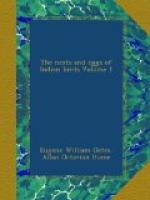[Footnote A: Mr. Hume, at one time separated the Indian Carrion-Crow from Corvus corone under the name C. pseudo-corone. In his ‘Catalogue’ he re-unites them. I quite agree with him that the two birds are inseparable.—ED.]
The only Indian eggs of the Carrion-Crow which I have seen, and one of which, with the parent bird, I owe to Mr. Brooks, were taken by the latter gentleman on the 30th May at Sonamerg, Cashmere.
The eggs were broad ovals, somewhat compressed towards one end, and of the regular Corvine type—a pretty pale green ground, blotched, smeared, streaked, spotted, and clouded, nowhere very profusely but most densely about the large end, with a greenish or olive-brown and pale sepia. The brown is a brighter and greener, or duller and more olive, lighter or darker, in different eggs, and even in different parts of the same egg. The shell is fine and close, but has only a faint gloss.
The eggs only varied from 1.67 to 1.68 in length, and from 1.14 to 1.18 in breadth.
Whether this bird breeds regularly or only as a straggler in Cashmere we do not know; it is always overlooked and passed by as a “Common Crow.” Future visitors to Cashmere should try and clear up both the identity of the bird and all particulars about its nidification.
4. Corvus macrorhynchus, Wagler. The Jungle-Crow.
Corvus culminatus, Sykes, Jerd. B, Ind.
ii, p. 295,
Corvus levaillantii; Less., Hume, Rough Draft N.
& E. no. 660.
The Jungle-Crow (under which head I include[A] C. culminatus, Sykes, C. intermedius, Adams, C. andamanensis, Tytler, and each and all of the races that occur within our limits) breeds almost everywhere in India, alike in the low country and in the hills both of Southern and Northern India, to an elevation of fully 8000 feet.
[Footnote A: See ‘Stray Feathers,’ vol. ii. 1874, p. 243, and ’Lahore to Yarkand,’ p. 85.]
March to May is, I consider, the normal breeding-season; in the plains the majority lay in April, rarely later, and in the hills in May; but in the plains a few birds lay also in February.
The nest is placed as a rule on good-sized trees and pretty near their summits. In the plains mangos and tamarinds seem to be preferred, but I have found the nests on many different kinds of trees. The nest is large, circular, and composed of moderate-sized twigs; sometimes it is thick, massive, and compact; sometimes loose and straggling; always with a considerable depression in the centre, which is smoothly lined with large quantities of horsehair, or other stiff hair, grass, grass-roots, cocoanut-fibre, &c. In the hills they use any animal’s hair or fur, if the latter is pretty stiff. They do not, according to my experience, affect luxuries in the way of soft down; it is always something moderately stiff, of the coir or horsehair type; nothing soft and fluffy. Coarse human hair, such as some of our native fellow-subjects can boast of, is often taken, when it can be got, in lieu of horsehair.




